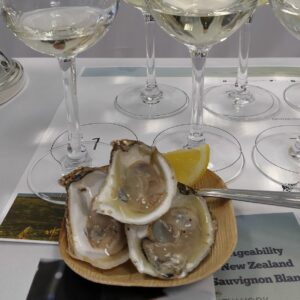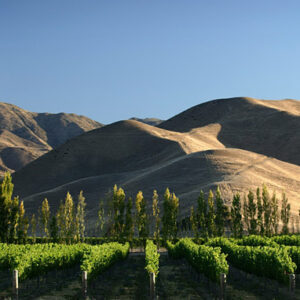The surge in popularity of New Zealand Sauvignon Blanc is a big trend in the US, and those of us in New York City love it as well. It is an ideal, refreshing wine for a hot summer’s day, pairing well with oysters and seafood; and it works all year round as the white wine crowd pleaser of choice. But a few weeks ago, during a wine seminar in New York City, I was shown that New Zealand Sauvignon Blanc could be so much more.
Place vs Grape Variety
 Sauvignon Blanc’s traditional home is in France. The great dry and sweet white wines of Bordeaux use a large portion of Sauvignon Blanc in their blends. The Loire Valley, also in France, makes the premium wines Sancerre and Pouilly Fumé from 100% Sauvignon Blanc. Most Old World winemaking countries, such as France, Italy and Spain, label a wine featuring the place instead of the grape variety. In the New World, such as the US, Australia and New Zealand, the grape variety takes precedence over the place, and thus, why we associate Sauvignon Blanc from New Zealand and Sancerre from France.
Sauvignon Blanc’s traditional home is in France. The great dry and sweet white wines of Bordeaux use a large portion of Sauvignon Blanc in their blends. The Loire Valley, also in France, makes the premium wines Sancerre and Pouilly Fumé from 100% Sauvignon Blanc. Most Old World winemaking countries, such as France, Italy and Spain, label a wine featuring the place instead of the grape variety. In the New World, such as the US, Australia and New Zealand, the grape variety takes precedence over the place, and thus, why we associate Sauvignon Blanc from New Zealand and Sancerre from France.
Reinventing Sauvignon Blanc
In 1973, Marlborough, New Zealand’s first Sauvignon Blanc vines were planted, and no one at that time could have even dreamt of the huge impact it would have on the wine world. Cloudy Bay Sauvignon Blanc, established in 1985 in Marlborough, introduced a type of white wine that was exciting to many wine drinkers. The “quintessential” New Zealand Sauvignon Blanc from their most famous area of Marlborough has an explosion of fruit with herbaceous notes of asparagus and thrilling high acidity which makes their wines addictive to many people around the world.
The success of Marlborough Sauvignon Blanc not only placed New Zealand on the map but it also helped to make the grape variety one of the most popular in the world. Their success has had its negatives as well as positives. The down side has been the unfair assessment that all New Zealand Sauvignon Blanc is the same. New Zealand has great diversity of soil and climate; so much so that they can produce world class wines that range from Syrah, Bordeaux blends, Pinot Noir, Chardonnay, and yes, our beloved Sauvignon Blanc. The styles of Sauvignon Blanc can be just as diverse, with some being more fruity, some more herbaceous and some more mineral driven. And even though many are meant to be drunk young, there are some smaller wineries producing wines that improve significantly with age.
Place Does Matter
 I think one of the biggest misconceptions that people have about New Zealand wines is that place does not matter as much as it does in European countries. That is not true, as tasting a large number of Sauvignon Blanc wines just from Marlborough will display the various terroirs (sense of place) within that one area alone.
I think one of the biggest misconceptions that people have about New Zealand wines is that place does not matter as much as it does in European countries. That is not true, as tasting a large number of Sauvignon Blanc wines just from Marlborough will display the various terroirs (sense of place) within that one area alone.
In the small island of Manhattan here in New York City, neighborhoods can change vastly within only five blocks and many people rarely leave a small radius within their own micro-neighborhood; but there is so much to see and so much to experience, we really need to push ourselves out of our own neighborhoods in order to grow. So if we want to truly know the full potential of the noble grape variety Sauvignon Blanc, and everything it can offer, then we need to try all the different “neighborhoods” in the new Sauvignon Blanc capital of the world.
Cathrine’s Recommendations
Everyday Drinking Wine (less than $15)
2014 Giesen Sauvignon Blanc, Marlborough, New Zealand ($10) : Bright citrus flavors, a hint of herbaceous notes with peppy acidity that finishes clean. This wine was not shown at the seminar but is a favorite of mine for an everyday drinking white wine.
Special Occasion Wine (from $15 to $50)
2015 Framingham Sauvignon Blanc, Marlborough, New Zealand ($20): For $10 more, one gets ten times higher quality. This wine alone is a great example of the diversity of New Zealand Sauvignon Blanc. A beautifully perfumed nose of flowers with mouthwatering passion fruit flavors on the palate. It is intensely linear with a heady aroma of white stone minerality. This wine speaks of a specific place in Marlborough, the Wairau Valley.
2008 Dog Point Section 94 Sauvignon Blanc, Marlborough, New Zealand ($30): It was a great gift to taste a New Zealand Sauvignon Blanc with eight years of age on it. Dog Point has always had a great reputation among those who know New Zealand wines well, and this wine proves they are not only great young, but they get so much more interesting with some age. This wine had layers of complexity with spice, rich nutty flavors, smoky minerality and a creamy texture that was balanced with lots of peach flavors. It should be noted that this wine has a cork instead of the more popular screw cap closure that is used on most wine bottles in New Zealand.
Fantasy Wine (over $50)
2013 Kumeu River, Chardonnay “Hunting Hill Vineyard”, Auckland, New Zealand ($55): I know this article focused on New Zealand Sauvignon Blanc, but I could not pass up the opportunity to talk about one of my favorite Chardonnay wines outside of Burgundy. This winery is located in the region of Auckland, New Zealand and shows what this country does best: producing wines with pristine fruit and a breathtakingly understated elegance. It is the best of the Old and New World combined. A deeply concentrated wine with pretty flavors of kaffir lime and white nectarine, transcended by hints of exotic spice and Earl Grey that had a riveting energy, carrying through the very long finish.












